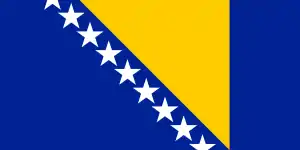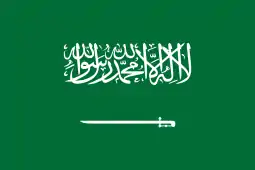Pistol Mitralieră model 1963/1965
The Pistol Mitralieră model 1963 (abbreviated PM md. 63 or simply md. 63) is an assault rifle patterned after the AKM, and chambered in the 7.62×39mm cartridge. It is exported as the AIM.
| PM md. 63/65 | |
|---|---|
 Cutaway of the PM md. 1963. | |
| Type | Assault rifle |
| Place of origin | Socialist Republic of Romania |
| Service history | |
| In service | 1963–present |
| Used by | See Users |
| Wars | Vietnam War The Troubles Nicaraguan Revolution Iran–Iraq War Lebanese Civil War[1] Lord's Resistance Army insurgency 1989 Romanian Revolution Gulf War[2] Yugoslav Wars[3] Transnistria War First Liberian Civil War Second Liberian Civil War[4] War in Afghanistan (2001–present)[5] Iraq War Syrian Civil War First Libyan Civil War Iraqi Civil War (2014–2017)[6] Second Libyan Civil War Yemeni Civil War (2015–present) |
| Production history | |
| Designer | Romtechnica |
| Designed | 1960s |
| Manufacturer | ROMARM via Regia Autonomă pentru producţia de Tehnică Militară (RATMIL), Cugir |
| Produced | 1963–1994 |
| Variants | PM md. 65, PM md. 90 |
| Specifications | |
| Mass | (without magazine) 3.45 kg (7.61 lb) (md. 63) 3.2 kg (7.1 lb) (md. 65) |
| Length | 870 mm (34.3 in) (md. 63) 870 mm (34.3 in) stock extended / 640 mm (25.2 in) stock folded (md. 65) |
| Barrel length | 415 mm (16.3 in) |
| Cartridge | 7.62×39mm |
| Action | Gas-operated reloading |
| Rate of fire | 600 rounds/min |
| Muzzle velocity | 715 m/s (2,346 ft/s) |
| Effective firing range | 100 to 1,000 m sight adjustments |
| Feed system | 30-round detachable box magazine |
| Sights | Rear sight notch on sliding tangent, front post, 378 mm (14.9 in) sight radius |
The Pistol Mitralieră model 1965 (abbreviated PM md. 65 or simply md. 65) is the underfolding-stock version of the md. 63, and is exported as the AIMS.
History
In the early 1960s, the Romanian Army used mostly PPSh-41, Oriţa submachine guns and imported AK-47 rifles. With the development of the stamped Type 4 AKM receiver, and the Soviet Union's call to each of the Warsaw Pact's nations to produce their own assault rifles chambered in 7.62mm, be they AK-47 pattern or not, the Romanian State Arsenal developed an AKM clone featuring a forward-pointing front handgrip molded into the lower handguard, called the Pistol Mitralieră model 1963 (literally 'machine pistol' model 1963). The underfolding stock version is designated the Pistol Mitralieră model 1965, and features a rear-pointing front handgrip, allowing the underfolding stock to be completely retracted.
Features
The PM md. 63/65 is almost identical to the AKM/AKMS, and thus is simple, inexpensive to manufacture, and easy to clean and maintain. The bore and chamber, as well as the gas piston and the interior of the gas cylinder, are generally chromium-plated. This plating dramatically increases the life of these parts by resisting corrosion and wear. Most md. 63/65 rifles lack a muzzle brake, but instead use a muzzle nut, as muzzle brakes entered production only in the late 1970s. The underfolding version is unique among the AKMS as it uses the thicker milled AKS type stock and arms, even locking only on the left side and being angled downwards just like the AKS. Some have speculated that the stocks may have even been surplus Romania purchased from Russia. The md 65's rear trunnion is also different compared to the standard AKMS's version, differing in that it only has the two locking holes on the left side, has only two pairs of rivets near the back of the trunnion and a bar connecting the two sides of the trunnion at the front. The navy is the only remaining large scale operator of the md. 65 because of the weight of the metal underfolding stock.
The fire selector markings are as follows, from top to bottom: Domestic—S, FA, FF. Export—S, A, R.
Operating Cycle
To fire, the operator inserts a loaded magazine, moves the selector lever to the lowest position, pulls back and releases the charging handle, and then pulls the trigger. In this setting, the gun fires once, requiring the trigger be released and depressed again for the next shot until the magazine is exhausted. With the selector in the middle position, the rifle continues to fire, automatically cycling fresh rounds into the chamber, until the magazine is exhausted or pressure is released from the trigger.
Disassembly
Dismantling the md. 63/65 is identical to dismantling the AKM and it involves the operator depressing the magazine catch and removing the magazine. The charging handle is pulled to the rear and the operator inspects the chamber to verify the weapon is unloaded. The operator presses forward on the retainer button at the rear of the receiver cover while simultaneously lifting up on the rear of the cover to remove it. The operator then pushes the spring assembly forward and lifts it from its raceway, withdrawing it out of the bolt carrier and to the rear. The operator must then pull the carrier assembly all the way to the rear, lift it, and then pull it away. The operator removes the bolt by pushing it to the rear of the bolt carrier; rotating the bolt so the camming lug clears the raceway on the underside of the bolt carrier and then pulls it forward and free. When cleaning, the operator will pay special attention to the barrel, bolt face, and gas piston, then oil lightly and reassemble.
Patriotic Guards version

The most-produced civilian export variation of this rifle is that of the 'Gardă' designation, produced for the Romanian Patriotic Guards. These rifles have a letter 'G' engraved on the left side of the rear sight block. The civil guard versions are modified by the removal of the sear and the modification of the disconnector to be semi-automatic only. Tens of thousands of these have been imported into the United States and sold as 'parts kits' (the receiver is destroyed by torch-cutting per BATF regulations – without the receiver, the kit is no longer legally considered a firearm). They are colloquially known among firearms enthusiasts as "Romy G's".
Other civilian versions
Other civilian 7.62mm Romanian AK clones are: SAR 1, WASR 10 (including WASR 10/63), Romak 991, Romak 1, and WUM 1. The Wieger rifle lookalikes known as the STG-2000 and STG-2003 are based on WASR 10 rifles, which are the only ones still in production.
A version of the PM md. 90 carbine is also available in the United States, known as the "Draco" it has the folding stock removed and thus the BATF sees it as a pistol and legal to import.
In Germany there are civilian versions on the market under the name / modell Cugir WS1-63 (fixed wood stock), WS1-64 (underfolder stock), WS1-64SB (Short Barrel 314mm with the underfolder stock).
The WS1-63HO is the straight pull non semi auto version. The gun must be charged after every shot that is fired.
PM md. 80
The Pistol Mitralieră model 1980 is a short barreled AK variant, and the first side-folding stock version produced in Romania. It featured a shorter gas block and usually used 20 round magazines. The front sight post is combined with the gas-block to provide an overall short length. The side folder is straight and folds to the left. There are two types of muzzle brakes used: a cylindrical one, and more commonly a slightly conical one. It is also known as the AIMR.
PM md. 90

The Pistol Mitralieră model 1990 is the 7.62mm response to the 5.45mm Pușcă Automată model 1986. It is internally identical to a PM md. 63/65, and outwardly differs in that it has a wire folding stock identical to the PA md. 86 stock, and that all of the rifles are fitted with slant brakes. It was extensively used in the Romanian Revolution of 1989 along with the md. 63 and md. 65
Short barrel version
The carbine version of the model 90, called simply PM md. 90 cu țeavă scurtă (short barreled PM md. 90), has a 12-inch [305 mm] barrel, an overall length of 31.69 inches [805 mm] (or 23.81 inches [605 mm] with the stock folded), and weighs 6.83 lbs. (3.1 kg) empty. It was designed for tank crews and special forces. Apart from the stock and the shortened barrel, it features the same modifications as the PM md. 80.
7.62 mm RPK
The RPK version of the md. 63 is called the md. 64. It is essentially identical to the Soviet RPK.
Users
 Afghanistan[7]
Afghanistan[7] Azerbaijan
Azerbaijan Bangladesh – Small numbers in use in the Bangladesh Army.[8]
Bangladesh – Small numbers in use in the Bangladesh Army.[8] Burundi[9]
Burundi[9] Bosnia and Herzegovina: Used by the preceding Army of the Republic of Bosnia and Herzegovina, captured in large numbers.
Bosnia and Herzegovina: Used by the preceding Army of the Republic of Bosnia and Herzegovina, captured in large numbers. Central African Republic[10]
Central African Republic[10] Croatia[3]
Croatia[3] Georgia[11]
Georgia[11] India: 100 000 were bought in 1995[12]
India: 100 000 were bought in 1995[12] Iraq – Used by military and police.[13]
Iraq – Used by military and police.[13] Liberia[14]
Liberia[14] Libya[15]
Libya[15] Macedonia[16]
Macedonia[16] Mali[17]
Mali[17] Morocco[18]
Morocco[18] Nicaragua[19]
Nicaragua[19] Niger[20]
Niger[20] Nigeria: Used by Nigerian Peacekeepers in Darfur.[21]
Nigeria: Used by Nigerian Peacekeepers in Darfur.[21] Palestine
Palestine.svg.png.webp) Socialist Republic of Romania/
Socialist Republic of Romania/ Romania: Used by Navy personnel, border guards, tank crews, reserve troops.[22][23][24]
Romania: Used by Navy personnel, border guards, tank crews, reserve troops.[22][23][24] Saudi Arabia[25]
Saudi Arabia[25] Sierra Leone[26]
Sierra Leone[26] Somalia[27]
Somalia[27] South Sudan[28]
South Sudan[28] Uganda[29]
Uganda[29] United States 100 AIMs used by US Army OPFOR in the 1980s.[30]
United States 100 AIMs used by US Army OPFOR in the 1980s.[30]
Nonstate users
Gallery
 A Romanian soldier armed with a PM md. 63/65 in 1989.
A Romanian soldier armed with a PM md. 63/65 in 1989..jpg.webp) Saudi Security Forces with PM md. 90.
Saudi Security Forces with PM md. 90. Afghan Police officers fire their PM md. 63 assault rifles.
Afghan Police officers fire their PM md. 63 assault rifles._Pfc._Cyres_Thompson%252C_right%252C_checks_out_his_shot_placement_while_U.S._Marine_Corps_Gunnery_Sgt._Daniel_Garcia%252C_a_mentor_for_the_AFL's_1st_Battalion%252C_23rd_Infantry_Brigade%252C_ensures_130426-F-ED706-093.jpg.webp) Liberian soldiers armed with MP md. 63
Liberian soldiers armed with MP md. 63 Moroccan Special Forces member with MP md. 63
Moroccan Special Forces member with MP md. 63.jpg.webp) Burundian peacekeeper in Somalia armed with MP md. 63
Burundian peacekeeper in Somalia armed with MP md. 63 U.S. Army Soldier from the 1st Stryker Brigade Combat Team return fire on insurgents from a rooftop in Buhriz, Iraq
U.S. Army Soldier from the 1st Stryker Brigade Combat Team return fire on insurgents from a rooftop in Buhriz, Iraq
References
- Katz, Sam (24 March 1988). Arab Armies of the Middle East Wars (2). Men-at-Arms 128. Osprey Publishing. p. 46. ISBN 9780850458008.
- "AKM type". iwm.org.uk. Imperial War Museum. Retrieved 19 February 2019.
- Mikulan, K; Thomas, Nigel (12 April 2006). The Yugoslav Wars (1): Slovenia & Croatia 1991–95. Elite 138. Osprey Publishing. pp. 24, 26. ISBN 9781841769639.
- http://imgur.com/a/k4BWY
- https://www.dvidshub.net/image/192635/afghan-us-forces-patrol-kandarou
- Fighting ISIS Combat So Close You Can Hear Their Voices. Diyala province, Iraq. March 2015. Event occurs at 0:23. Retrieved 25 May 2015.
- c:File:Afghan elite police units close quarters battle training 110823-N-TH989-035.jpg
- http://www.bdmilitary.com/index.php?option=com_content&view=article&id=204&Itemid=95
- c:File:Burundian Positions in Deynile 19-2 (6430134427).jpg
- Berman, Eric G.; Lombard, Louisa N. (December 2008). The Central African Republic and Small Arms: A Regional Tinderbox (PDF). Small Arms Survey. pp. 82, 94. ISBN 2-8288-0103-9.
- http://www.ziare.com/stiri/ancheta/csat-a-acoperit-inselatoria-romaniei-in-ce-priveste-comertul-cu-arme-372546
- Sandeep Unnithan (30 December 2013). "Why General Kalashnikov couldn't sell the AK in India". intoday.in. Retrieved 15 August 2017.
- Rottman, Gordon (24 May 2011). The AK-47: Kalashnikov-series assault rifles. Osprey Publishing. pp. 49, 63. ISBN 978-1-84908-835-0.
- c:File:Armed Forces of Liberia (AFL) Pfc. Cyres Thompson, right, checks out his shot placement while U.S. Marine Corps Gunnery Sgt. Daniel Garcia, a mentor for the AFL's 1st Battalion, 23rd Infantry Brigade, ensures 130426-F-ED706-093.jpg
- "World Infantry Weapons: Libya". Archived from the original on 5 October 2016.
- c:File:Macedonian soldiers celebrate army birthday DVIDS311942.jpg
- Touchard, Laurent (11 June 2014). "Défense : où en sont les Forces armées maliennes ?". Jeune Afrique (in French).
- c:File:Flintlock 2017 range training in Morocco 170301-M-ZG301-040.jpg
- Jurado, Carlos Caballero (1990). Central American Wars 1959-89. Men-at-Arms 221. London: Osprey Publishing. p. 46. ISBN 9780850459456.
- c:File:Nigerian lieutnant of the National Guard along Komadogou 2016.jpg
- Albert Gonzalez Farran (13 November 2013). "Displaced families in Labado". UNAMID. Retrieved 4 June 2017.
- willyp (26 November 2007). "AIM (AKM) Variants (7.62x39)". Image Event. Retrieved 22 June 2017.
- partisan1943 (11 March 2015). "Eastern Bloc militaries". Tumblr. Retrieved 22 June 2017.
- nineoclock (15 August 2015). "Navy Day: Romanian Naval Forces celebrate 155th anniversary by impressive air, sea and land exercise". nineoclock.ro. Retrieved 22 June 2017.
- https://www.flickr.com/photos/aljazeeraenglish/4125431345/
- "World Infantry Weapons: Sierra Leone". 2013. Archived from the original on 24 November 2016.
- https://www.flickr.com/photos/au_unistphotostream/7325752932/
- Persecution Project Foundation (4 March 2011). "SOUTH SUDAN: The World's Newest Nation Emerges from Africa's Longest War". Persecution Project Foundation. Retrieved 25 June 2017.
- Small Arms Survey (2006). "Fuelling Fear: The Lord's Resistance Army and Small Arms" (PDF). Small Arms Survey 2006: Unfinished Business. Oxford University Press. p. 283. ISBN 978-0-19-929848-8.
- Rottman 2011, p. 64.
- Romanian Export Kalashnikov versions at Romanian Kalashnikov Rifles
- Kalashnikov guns website (confuses the md. 63 designation for the md. 65)
- WASR-10.com - Information on the Export Version of the md. 63/65
- SC Fabrica de Arme Cugir SA - Arms Factory - md. 63 Assault Rifle
- SC Fabrica de Arme Cugir SA - Arms Factory - md. 65 Assault Rifle
- SC Fabrica de Arme Cugir SA - Arms Factory - md. 90 Assault Rifle
- SC Fabrica de Arme Cugir SA - Arms Factory - md. 90 Carbine
| Wikimedia Commons has media related to PM md. 63. |
